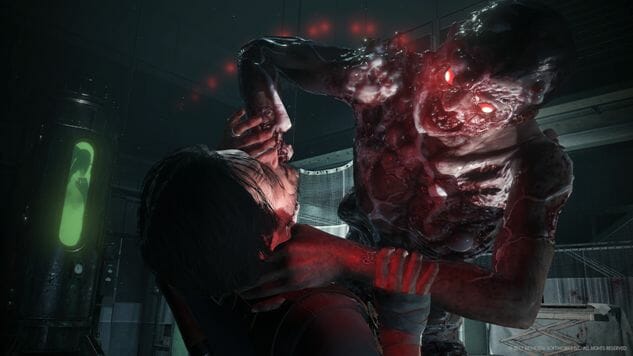The Evil Within 2: A Horror Series Finds an Identity, Sort Of

I’m what you call a horror game minimalist. I think the mood and atmosphere of a horror game can be completely destroyed by popular videogame conventions. Garish and invasive UI elements, shoehorned crafting mechanisms, mindless fetch and collection quests: there are a number of features we accept as an established part of the framework of a game that can be a distraction in a genre that relies on tension, pacing and environment.
As an example, take a look at the original F.E.A.R. and F.E.A.R. 3. The raw simplicity of the first game let the narrative stand on its own two feet, while making the shooting segments quicker to adapt to and the horror events appeasingly consumed in small bites. F.E.A.R. 3, however, was an obnoxious display of shooting game mainstays, from multiplayer modes, to a co-op scoring system that in context and appearance was almost vulgar. In trying to be more like other games, what made F.E.A.R. special and effective all but disappeared.
The Evil Within, in trying to be like other games, had no identity of its own at all. To be honest, when I first settled in with the original, I think I expected to be entertained (as with most horror games) first by the narrative, with some enjoyment of the mechanics as a secondary experience. But the the game’s level design was bizarrely linear, almost stunted feeling, and the combat itself was simple, almost lackluster, utilizing well worn stealth game staples without refining or elaborating on them. It was hours before I realized, “oh, was I supposed to be enjoying that? This is like, the actual game now, not an extended tutorial area? Well shit, this is awkward.”
Thankfully, The Evil Within 2 is an improvement on itself, if not on the many established tropes it borrows from. In some ways it is actually better off for adopting some of the stalest features in the entire medium: the improved stealth system successfully adds some necessary intrigue and tension to the combat, and the open world exploration is miles more entertaining than the obnoxiously stilted play areas of the game before. There’s even a map and a well organized user interface! Both are already an almost universal, basic necessity in videogames, but better late than never, right?
-

-

-

-

-

-

-

-

-

-

-

-

-

-

-

-

-

-

-

-

-

-

-

-

-

-

-

-

-

-

-

-

-

-

-

-

-

-

-

-








































